Carbon Losses from Topsoil in Abandoned Peat Extraction Sites Due to Ground Subsidence and Erosion
Abstract
:1. Introduction
2. Materials and Methods
2.1. Research Sites
2.2. Soil Analyses
2.3. Carbon Loss Estimation
2.4. Statistical Analysis
3. Results
3.1. Evaluation of Ground Elevation Changes in Peatlands
3.2. Evaluation of Carbon Losses Due to Subsidence and Erosion
3.3. Evaluation of Affecting Factors and Total Carbon Losses
4. Discussion
4.1. Ground Elevation Changes
4.2. Carbon Losses
5. Conclusions
Author Contributions
Funding
Data Availability Statement
Conflicts of Interest
References
- Joosten, H. Peatlands across the Globe. In Peatland Restoration and Ecosystem Services: Science, Policy and Practice; Bonn, A., Allott, T., Evans, M., Joosten, H., Stoneman, R., Eds.; Cambridge University Press: Cambridge, UK, 2016; pp. 19–43. [Google Scholar]
- Li, C.; Grayson, R.; Holden, J.; Li, P. Erosion in peatlands: Recent research progress and future directions. Earth-Sci. Rev. 2018, 185, 870–886. [Google Scholar] [CrossRef]
- Hilbert, D.W.; Roulet, N.; Moore, T. Modelling and analysis of peatlands as dynamical systems. J. Ecol. 2000, 88, 230–242. [Google Scholar] [CrossRef]
- Frolking, S.; Talbot, J.; Jones, M.C.; Treat, C.C.; Kauffman, J.B.; Tuittila, E.-S.; Roulet, N. Peatlands in the Earth’s 21st century climate system. Environ. Rev. 2011, 19, 371–396. [Google Scholar] [CrossRef]
- Xu, J.; Morris, P.J.; Liu, J.; Holden, J. PEATMAP: Refining estimates of global peatland distribution based on a meta-analysis. Catena 2018, 160, 134–140. [Google Scholar] [CrossRef]
- McNeil, P.; Waddington, J.M.; Lavoie, C.; Price, J.S.; Rochefort, L. Contemporary and long-term peat oxidation rates in a post-vacuum harvested peatland. In Sustaining Our Peatlands, Proceedings of the 11th International Peat Congress, Edmonton, AB, Canada, 6–12 August 2000; Rochefort, L., Daigle, J.Y., Eds.; Canadian Society of Peat and Peatlands & International Peat Society: Quebec city, QC, Canada, 2000; Volume 2, pp. 732–741. [Google Scholar]
- Campbell, D.R.; Lavoie, C.; Rochefort, L. Wind erosion and surface stability in abandoned milled peatlands. Can. J. Soil Sci. 2002, 82, 85–95. [Google Scholar] [CrossRef]
- Littlewood, N.; Anderson, P.; Artz, R. Peatland Biodiversity. Report to IUCN UK Peatland Programme, Edinburgh. Available online: www.iucn-uk-peatlandprogramme.org/scientificreviews (accessed on 14 September 2023).
- Kløve, B. Erosion and sediment delivery from peat mines. Soil Tillage Res. 1998, 45, 199–216. [Google Scholar] [CrossRef]
- Evans, M.; Lindsay, J. High resolution quantification of gully erosion in upland peatlands at the landscape scale. Earth Surf. Process Landf. 2010, 35, 876–886. [Google Scholar] [CrossRef]
- Evans, M.; Lindsay, J. Impact of gully erosion on carbon sequestration in blanket peatlands. Clim. Res. 2010, 45, 31–41. [Google Scholar] [CrossRef]
- Li, C.; Holden, J.; Grayson, R. Effects of rainfall, overland flow and their interactions on peatland interrill erosion processes. Earth Surf. Process Landf. 2018, 43, 1451–1464. [Google Scholar] [CrossRef]
- McLay, C.D.A.; Allbrook, R.F.; Thompson, K. Effects of development and cultivation on physical properties of peat soils in New Zealand. Geoderma 1992, 54, 23–37. [Google Scholar] [CrossRef]
- Price, J.S.; Schlotzhauer, S.M. Importance of shrinkage and compression in determining water storage changes in peat: The case of a mined peatland. Hydrol. Proc. 1999, 13, 2591–2601. [Google Scholar] [CrossRef]
- Holden, J.; Chapman, P.J.; Labadz., J.C. Artificial drainage of peatlands: Hydrological and hydrochemical process and wetland restoration Progress in Physical Geography. Earth Environ. 2004, 28, 95–123. [Google Scholar]
- Van Hardeveld, H.A.; Driessen, P.P.J.; Schot, P.P.; Wassen, M.J. an integrated modelling framework to assess long-term impacts of water management strategies steering soil subsidence in peatlands. Environ. Impact Assess. Rev. 2017, 66, 66–77. [Google Scholar] [CrossRef]
- Leifeld, J.; Menichetti, L. The underappreciated potential of peatlands in global climate change mitigation strategies. Nat. Commun. 2018, 9, 1071. [Google Scholar] [CrossRef]
- Ikkala, L.; Ronkanen, A.-K.; Utriainen, O.; Kløve, B.; Marttila, H. Peatland subsidence enhances cultivated lowland flood risk. Soil Tillage Res. 2021, 212, 105078. [Google Scholar] [CrossRef]
- Wösten, J.H.M.; Ismail, A.B.; Van Wijk, A.L.M. Peat subsidence and its practical implications: A case study in Malaysia. Geoderma 1997, 78, 25–36. [Google Scholar] [CrossRef]
- Evans, C.D.; Williamson, J.M.; Kacaribu, F.; Irawan, D.; Suardiwerianto, Y.; Hidayat, M.F.; Laurén, A.; Page, S.E. Rates and spatial variability of peat subsidence in Acacia plantation and forest landscapes in Sumatra, Indonesia. Geoderma 2019, 338, 410–421. [Google Scholar] [CrossRef]
- van Asselen, S.; Erkens, G.; and de Graaf, F. Monitoring shallow subsidence in cultivated peatlands. Proc. IAHS 2020, 382, 189–194. [Google Scholar] [CrossRef]
- Davidson, E.; Janssens, I. Temperature sensitivity of soil carbon decomposition and feedbacks to climate change. Nature 2006, 440, 165–173. [Google Scholar] [CrossRef]
- Elder, J.W.; Lal, R. Tillage effects on physical properties of agricultural organic soils of north central Ohio. Soil Tillage Res. 2008, 98, 208–210. [Google Scholar] [CrossRef]
- Dawson, Q.; Kechavarzi, C.; Leeds-Harrison, P.; Burton, R.G.O. Subsidence and degradation of agricultural peatlands in the Fenlands of Norfolk, UK. Geoderma 2010, 154, 181–187. [Google Scholar] [CrossRef]
- Grzywna, A. The degree of peatland subsidence resulting from drainage of land. Environ. Earth Sci. 2017, 76, 559. [Google Scholar] [CrossRef]
- Maijala, T. About Subsidence of Relictions. In Viljeltyjen Vesijättöjen Painumisesta; National Board of Waters and the Environment: Helsinki, Finland, 1992. [Google Scholar]
- Grönlund, A.; Hauge, A.; Hovde, A.; Rasse, D.P. Carbon loss estimates from cultivated peat soils in Norway: A comparison of three methods. Nutr. Cycl. Agroecosyst. 2008, 81, 157–167. [Google Scholar] [CrossRef]
- Leifeld, J.; Müller, M.; Fuhrer, J. Peatland subsidence and carbon loss from drained temperate fens. Soil Use Manag. 2011, 27, 170–176. [Google Scholar] [CrossRef]
- Oleszczuk, R.; Zając, E.; Urbański, J. Verification of empirical equations describing subsidence rate of peatland in Central Poland. Wetlands Ecol. Manag. 2020, 28, 495–507. [Google Scholar] [CrossRef]
- Jeziorska, J. UAS for Wetland Mapping and Hydrological Modeling. Remote Sens. 2019, 11, 1997. [Google Scholar] [CrossRef]
- Evans, M.; Warburton, J. The Geomorphology of Upland Peat: Erosion, Form and Landscape Change; Wiley-Blackwell: Oxford, UK, 2007. [Google Scholar]
- Scholefield, P.; Morton, D.; McShane, G.; Carrasco, L.; Whitfield, M.G.; Rowland, C.; Rose, R.; Wood, C.; Tebbs, E.; Dodd, B.; et al. Estimating habitat extent and carbon loss from an eroded northern blanket bog using UAV derived imagery and topography. Prog. Phys. Geogr. 2019, 43, 282–298. [Google Scholar] [CrossRef]
- Evans, M.; Warburton, J.; Yang, J. Eroding blanket peat catchments: Global and local implications of upland organic sediment budgets. Geomorphology 2006, 79, 45–57. [Google Scholar] [CrossRef]
- Glendell, M.; McShane, G.; Farrow, L.; James, M.R.; Quinton, J.; Anderson, K.; Brazier, R.E. Testing the utility of structure-from-motion photogrammetry reconstructions using small unmanned aerial vehicles and ground photography to estimate the extent of upland soil erosion. Earth Surf. Process Landf. 2017, 42, 1860–1871. [Google Scholar] [CrossRef]
- Grayson, R.; Holden, J.; Jones, R.R.; Carle, J.A.; Lloyd, A.R. Improving particulate carbon loss estimates in eroding peatlands through the use of terrestrial laser scanning. Geomorphology 2012, 179, 240–248. [Google Scholar] [CrossRef]
- Rothwell, J.J.; Lindsay, J.B.; Evans, M.G.; Allott, T.E.H. Modelling suspended sediment lead concentrations in contaminated peatland catchments using digital terrain analysis. Ecol. Eng. 2010, 36, 623–630. [Google Scholar] [CrossRef]
- Simpson, J.; Wooster, M.; Smith, T.; Trivedi, M.; Vernimmen, R.; Dedi, R.; Shakti, M.; Dinata, Y. Tropical Peatland Burn Depth and Combustion Heterogeneity Assessed Using UAV Photogrammetry and Airborne LiDAR. Remote Sens. 2016, 8, 1000. [Google Scholar] [CrossRef]
- Ikkala, L.; Ronkanen, A.-K.; Ilmonen, J.; Similä, M.; Rehell, S.; Kumpula, T.; Päkkilä, L.; Klöve, B.; Marttila, H. Unmanned Aircraft System (UAS) Structure-From-Motion (SfM) for Monitoring the Changed Flow Paths and Wetness in Minerotrophic Peatland Restoration. Remote Sens. 2022, 14, 3169. [Google Scholar] [CrossRef]
- Kalacska, M.; Arroyo-Mora, J.P.; Lucanus, O. Comparing UAS LiDAR and Structure-from-Motion Photogrammetry for peatland mapping and virtual reality (VR) visualization. Drones 2021, 5, 36. [Google Scholar] [CrossRef]
- ISO 11272:2017; Soil Quality—Determination of Dry Bulk Density. International Organization for Standardization: Geneva, Switzerland, 2017.
- ISO 11464:2006; Soil Quality—Pretreatment of Samples for Physico-Chemical Analysis. International Organization for Standardization: Geneva, Switzerland, 2006.
- ISO 13878:1998; Soil Quality—Determination of Total Nitrogen Content by Dry Combustion (“Elemental Analysis”). International Organization for Standardization: Geneva, Switzerland, 1998.
- Sloan, T.; Payne, R.J.; Anderson, R.; Gilbert, P.; Mauquoy, D.; Newton, A.; Andersen, R. Ground surface subsidence in an afforested peatland fifty years after drainage and planting. Mires Peat 2019, 23, 1–12. [Google Scholar]
- R Core Team. R: A Language and Environment for Statistical Computing; R Foundation for Statistical Computing: Vienna, Austria, 2023; Available online: https://www.R-project.org/ (accessed on 14 September 2023).
- Parent, L.E.; Millette, J.A.; Mehuys, G.R. Subsidence and Erosion of a Histosoil. Soil Sci. Soc. Am. J. 1982, 46, 404. [Google Scholar] [CrossRef]
- Regan, S.; Flynn, R.; Gill, L.; Naughton, O.; Johnston, P. Impacts of groundwater drainage on peatland subsidence and its ecological implications on an Atlantic raised bog. Water Re. Res. 2019, 55, 6153–6168. [Google Scholar] [CrossRef]
- Fell, H.; Roßkopf, N.; Bauriegel, A.; Zeitz, J. Estimating vulnerability of agriculturally used peatlands in north-east Germany to carbon loss based on multi-temporal subsidence data analysis. Catena 2016, 137, 61–69. [Google Scholar] [CrossRef]
- Lupikis, A.; Lazdins, A. Soil carbon stock changes in transitional mire drained for forestry in Latvia: A case study. In Proceedings of the Research for Rural Development 2017: Annual 23rd International Scientific Conference Proceedings, Latvia, Jelgava, 17–19 May 2017; Latvia University of Agriculture: Jelgava, Latvia, 2017; Volume 1, pp. 55–61. [Google Scholar]
- Anshari, G.Z.; Gusmayanti, E.; Novita, N. The Use of Subsidence to Estimate Carbon Loss from Deforested and Drained Tropical Peatlands in Indonesia. Forests 2021, 12, 732. [Google Scholar] [CrossRef]
- Hooijer, A.; Page, S.; Jauhiainen, J.; Lee, W.A.; Lu, X.X.; Idris, A.; Anshari, G. Subsidence and carbon loss in drained tropical peatlands. Biogeosciences 2012, 9, 1053–1071. [Google Scholar] [CrossRef]
- Harris, A.; Baird, A.J. Microtopographic drivers of vegetation patterning in blanket peatlands recovering from erosion. Ecosystems 2019, 22, 1035–1054. [Google Scholar] [CrossRef]
- Shuttleworth, E.L.; Evans, M.G.; Hutchinson, S.M.; Rothwell, J.J. Peatland restoration: Controls on sediment production and reductions in carbon and pollutant export. Earth Surf. Process Landf. 2000, 40, 459–472. [Google Scholar] [CrossRef]
- Zhongming, W.; Lees, B.G.; Feng, J.; Wanning, L.; Haijing, S. Stratified vegetation cover index: A new way to assess vegetation impact on soil erosion. Catena 2010, 83, 87–93. [Google Scholar] [CrossRef]
- Kløve, B. Retention of suspended solids and sediment bound nutrients from peat harvesting sites with peak runoff control, constructed floodplains and sedimentation ponds. Boreal Environ. Res. 2000, 5, 81–94. [Google Scholar]
- Marttila, H.; Kløve, B. Erosion and delivery of deposited peat sediment. Water Resour. Res. 2008, 44. [Google Scholar] [CrossRef]
- Hyvönen, N.P.; Huttunen, J.T.; Shurpali, N.J.; Tavi, N.M.; Repo, M.E.; Martikainen, P.J. Fluxes of nitrous oxide and methane on an abandoned peat extraction site: Effect of reed canary grass cultivation. Bioresour. Technol. 2009, 100, 4723–4730. [Google Scholar] [CrossRef]
- Krüger, J.P.; Leifeld, J.; Glatzel, S.; Szidat, S.; Alewell, C. Biogeochemical indicators of peatland degradation—A case study of a temperate bog in northern Germany. Biogeosciences 2015, 12, 2861–2871. [Google Scholar] [CrossRef]

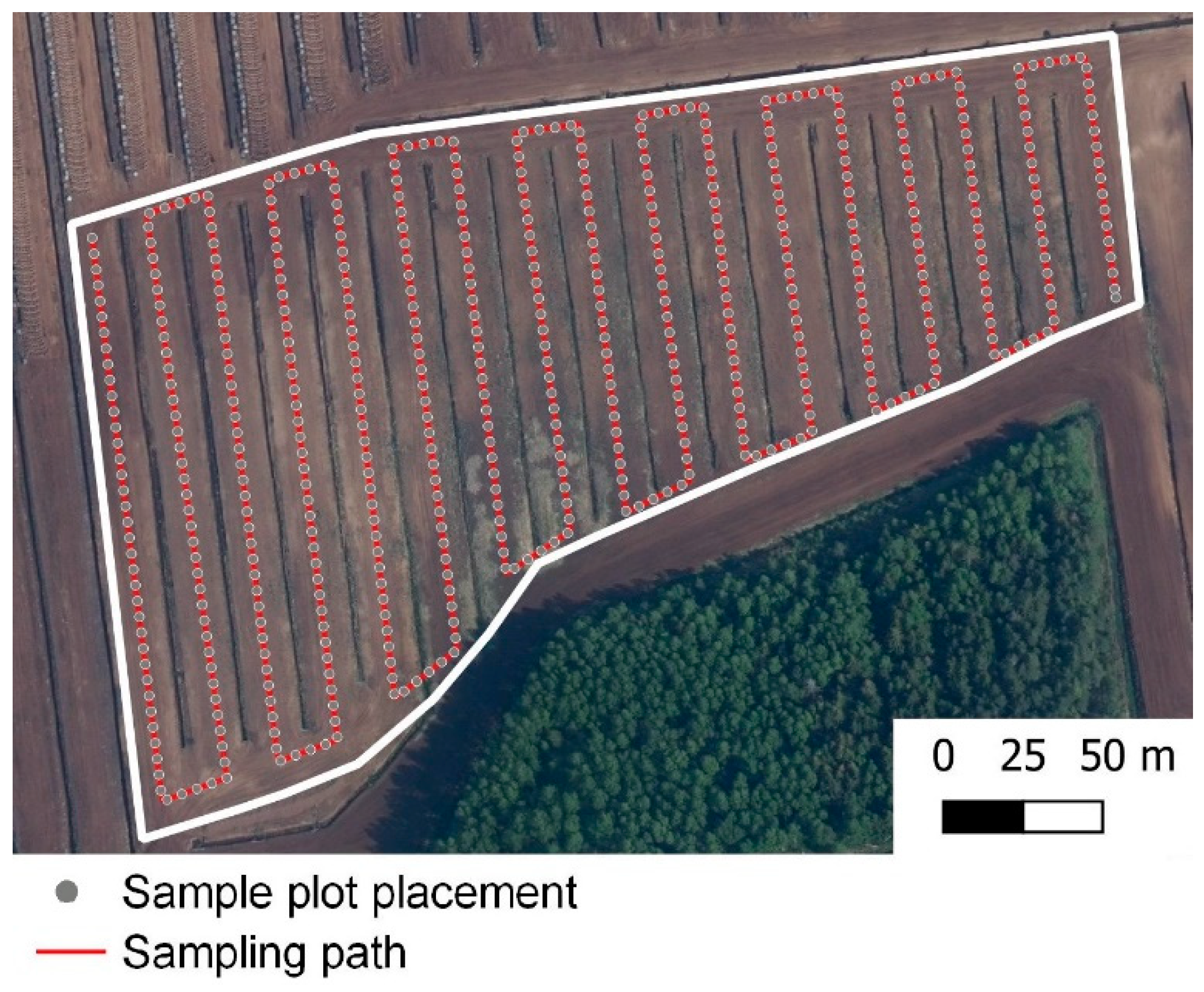
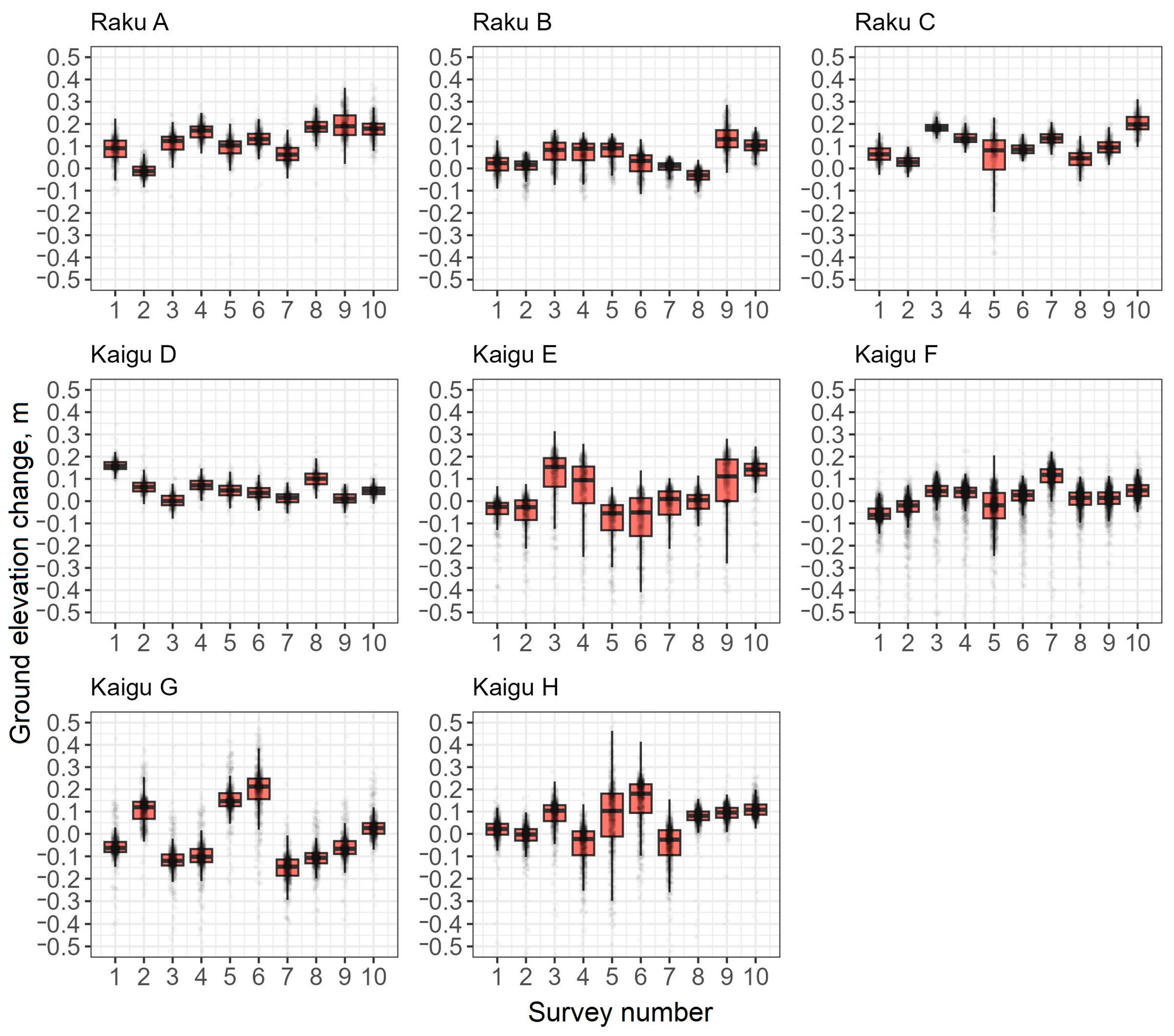
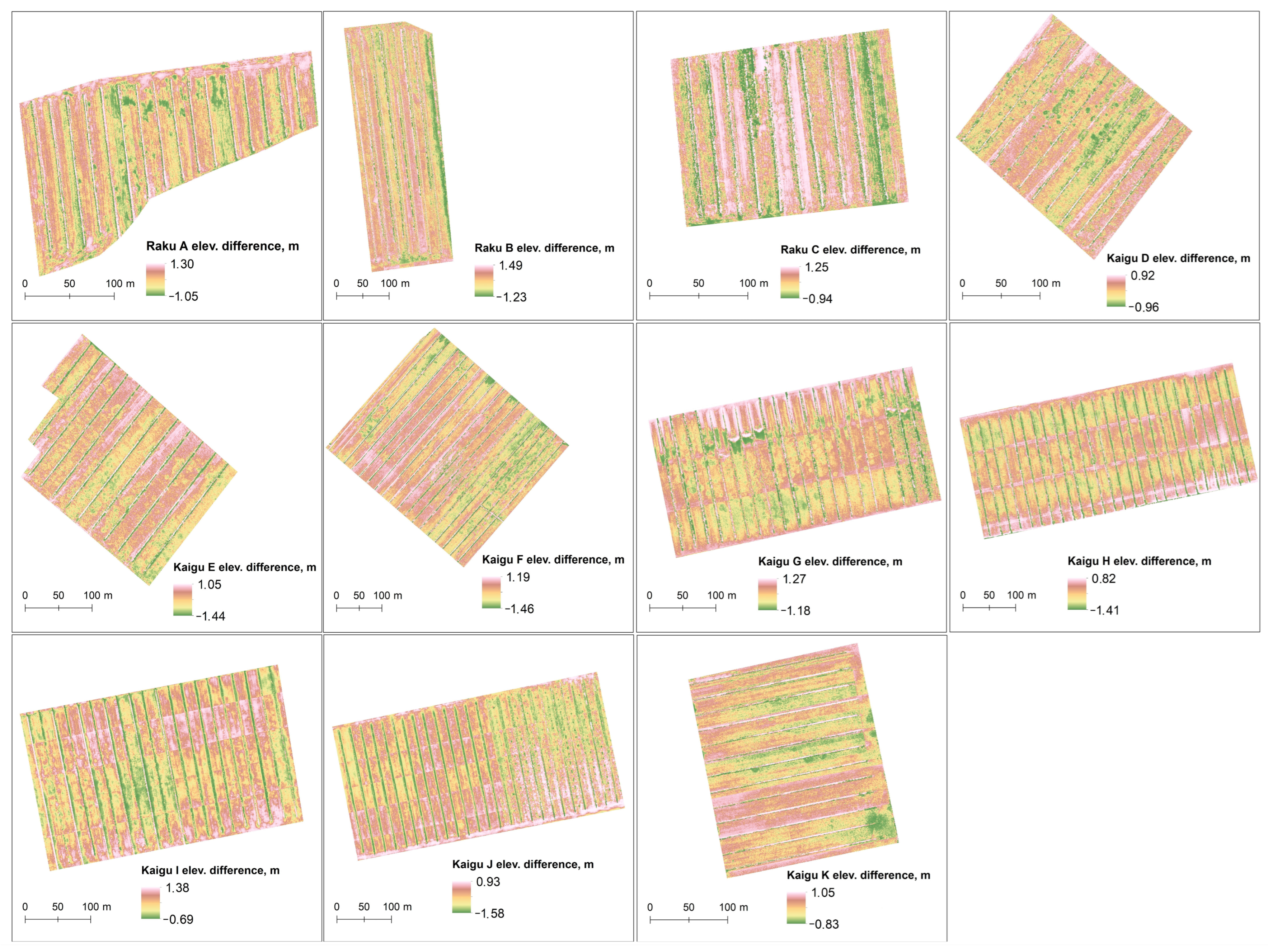


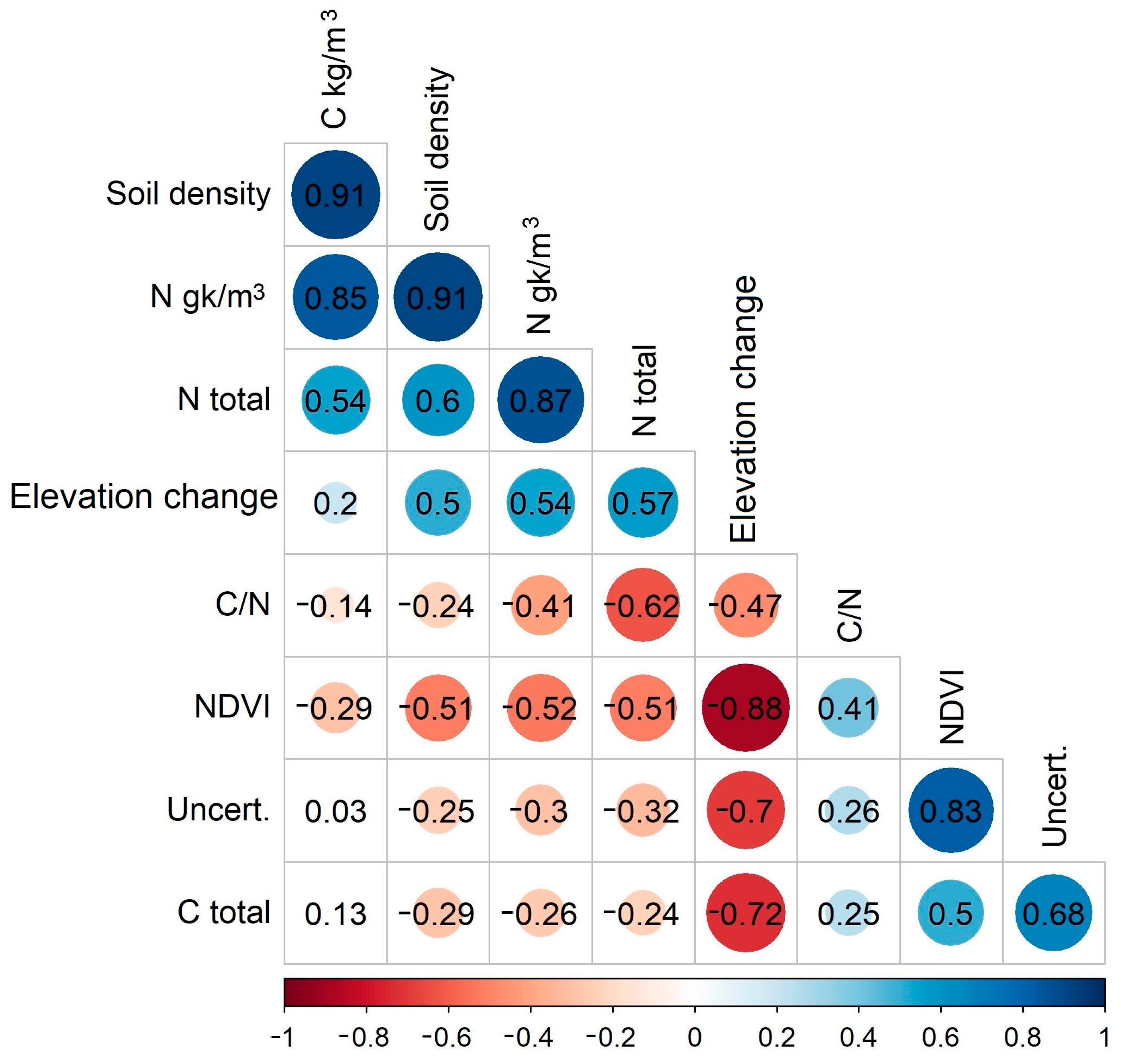
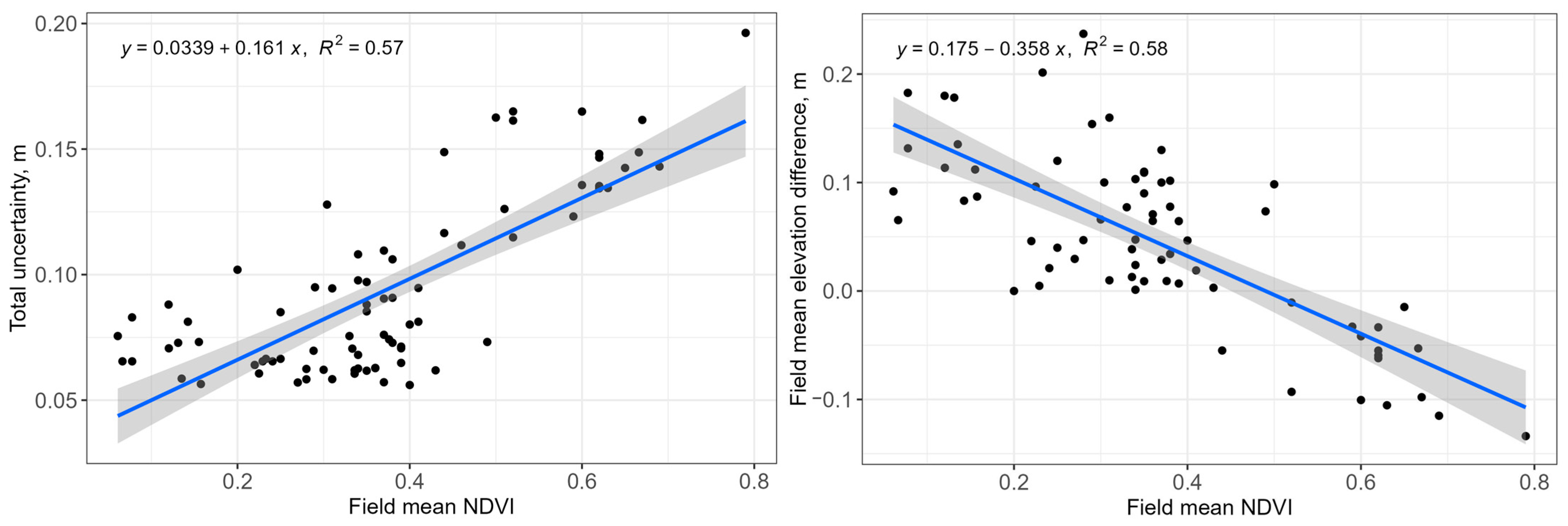
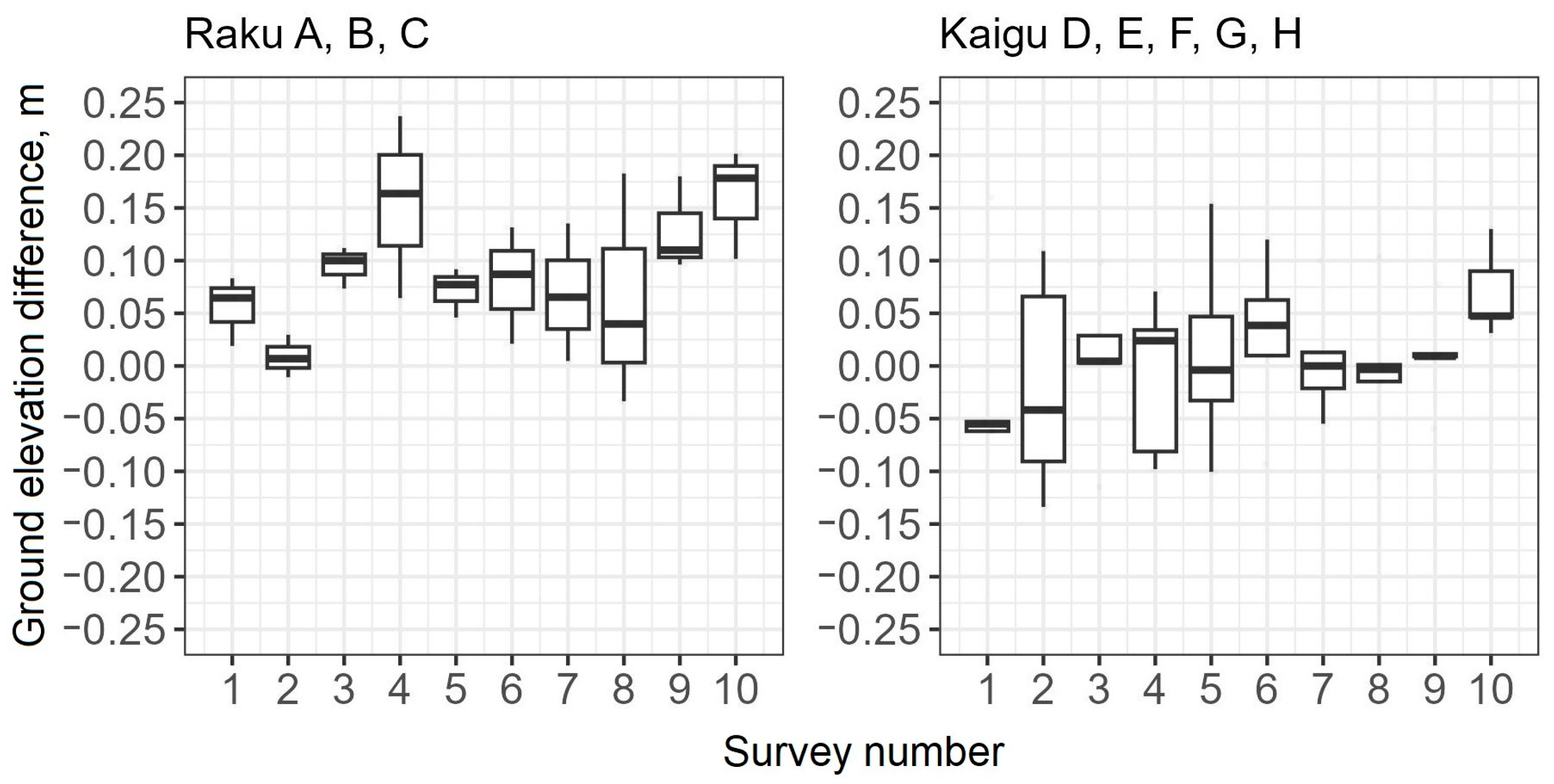
| Name of Research Sites | Short Description of Research Site | Date of Survey (Rāķu Mire) | Date of Survey (Kaigu Mire) | Coordinates (LKS92 TM, EPSG:3059) |
|---|---|---|---|---|
| Raku Mire, Fields A, B, C Kaigu mire, Fields D, E, F, G, H, I, J, K | Abandoned peat extraction fields (bare peat), Fibric Histosol (according to WRB 2022) | 24 September 2019. | 30 September 2014. | Raku mire (X: 555374, Y: 382724); Kaigu mire (X: 474835, Y: 286989) |
| 15 June 2021. | 17 June 2021. | |||
| 29 June 2021. | 30 June 2021. | |||
| 7 August 2021. | 3 August 2021. | |||
| 8 September 2021. | 9 September 2021. | |||
| 8 October 2021. | 5 October 2021. | |||
| 13 November 2021. | 12 November 2021. | |||
| 22 March 2022. | 23 March 2022. | |||
| 16 June 2022. | 17 June 2022. | |||
| 25 July 2022. | 27 July 2022. | |||
| 10 May 2023. | 11 May 2023. |
| Field | Soil Density, kg m−3 | C tot., g kg | N tot., g kg | C:N | C kg m−3 | N kg m−3 |
|---|---|---|---|---|---|---|
| A | 131.50 ± 40.91 | 496.40 ± 89.26 | 13.45 ± 5.71 | 39.89 ± 9.62 | 62.42 ± 8.01 | 1.68 ± 0.54 |
| B | 119.85 ± 42.78 | 478.06 ± 25.55 | 13.71 ± 2.56 | 36.12 ± 7.20 | 56.59 ± 18.76 | 1.71 ± 0.82 |
| C | 159.40 ± 52.86 | 444.95 ± 107.86 | 11.04 ± 2.35 | 41.77 ± 14.36 | 66.59 ± 13.78 | 1.71 ± 0.51 |
| D | 73.38 ± 6.24 | 505.92 ± 13.00 | 9.08 ± 1.07 | 56.41 ± 6.07 | 37.14 ± 3.50 | 0.67 ± 0.13 |
| E | 85.53 ± 14.27 | 509.67 ± 13.58 | 10.25 ± 1.74 | 51.26 ± 9.02 | 43.56 ± 7.09 | 0.90 ± 0.30 |
| F | 100.30 ± 26.15 | 516.06 ± 24.30 | 9.70 ± 1.54 | 52.65 ± 8.09 | 51.80 ± 14.29 | 1.01 ± 0.39 |
| G | 99.63 ± 11.63 | 516.81 ± 11.76 | 7.93 ± 1.84 | 69.16 ± 17.53 | 51.58 ± 6.95 | 0.80 ± 0.26 |
| H | 140.28 ± 23.47 | 539.93 ± 19.62 | 12.22 ± 2.49 | 45.78 ± 7.98 | 76.17 ± 14.85 | 1.76 ± 0.58 |
| I | 136.60 ± 16.62 | 537.40 ± 11.77 | 11.33 ± 0.28 | 47.54 ± 2.12 | 73.56 ± 10.62 | 1.55 ± 0.21 |
| J | 132.93 ± 19.04 | 534.87 ± 10.22 | 10.43 ± 0.51 | 51.01 ± 2.17 | 70.95 ± 11.48 | 1.34 ± 0.27 |
| K | 111.85 ± 20.12 | 524.86 ± 5.52 | 10.27 ± 1.82 | 52.86 ± 9.84 | 58.78 ± 11.01 | 1.17 ± 0.34 |
| Field | C kg m−3 | Elevation Decrease, cm y−1 | Peat Volume, m3 m−2 y−1 | C Loss, kg m−2 y−1 |
|---|---|---|---|---|
| A | 62.42 ± 8.01 | 5.72 ± 5.4 | 0.0572 ± 0.054 | 3.57 ± 4.06 |
| B | 56.59 ± 18.76 | 2.14 ± 5.7 | 0.0214 ± 0.057 | 1.21 ± 5.12 |
| C | 66.59 ± 13.78 | 4.4 ± 3.4 | 0.044 ± 0.034 | 2.93 ± 2.97 |
| D | 37.14 ± 3.50 | 0.58 ± 3.5 | 0.0058 ± 0.035 | 0.22 ± 1.63 |
| E | 43.56 ± 7.09 | 0.41 ± 14.0 | 0.0041 ± 0.140 | 0.18 ± 8.38 |
| F | 51.80 ± 14.29 | 0.36 ± 9.1 | 0.0036 ± 0.091 | 0.19 ± 7.22 |
| G | 51.58 ± 6.95 | 0.1 ± 8.2 | 0.001 ± 0.082 | 0.05 ± 5.33 |
| H | 76.17 ± 14.85 | 0.08 ± 8.3 | 0.0008 ± 0.083 | 0.06 ± 7.91 |
Disclaimer/Publisher’s Note: The statements, opinions and data contained in all publications are solely those of the individual author(s) and contributor(s) and not of MDPI and/or the editor(s). MDPI and/or the editor(s) disclaim responsibility for any injury to people or property resulting from any ideas, methods, instructions or products referred to in the content. |
© 2023 by the authors. Licensee MDPI, Basel, Switzerland. This article is an open access article distributed under the terms and conditions of the Creative Commons Attribution (CC BY) license (https://creativecommons.org/licenses/by/4.0/).
Share and Cite
Meļņiks, R.N.; Bārdule, A.; Butlers, A.; Champion, J.; Kalēja, S.; Skranda, I.; Petaja, G.; Lazdiņš, A. Carbon Losses from Topsoil in Abandoned Peat Extraction Sites Due to Ground Subsidence and Erosion. Land 2023, 12, 2153. https://doi.org/10.3390/land12122153
Meļņiks RN, Bārdule A, Butlers A, Champion J, Kalēja S, Skranda I, Petaja G, Lazdiņš A. Carbon Losses from Topsoil in Abandoned Peat Extraction Sites Due to Ground Subsidence and Erosion. Land. 2023; 12(12):2153. https://doi.org/10.3390/land12122153
Chicago/Turabian StyleMeļņiks, Raitis Normunds, Arta Bārdule, Aldis Butlers, Jordane Champion, Santa Kalēja, Ilona Skranda, Guna Petaja, and Andis Lazdiņš. 2023. "Carbon Losses from Topsoil in Abandoned Peat Extraction Sites Due to Ground Subsidence and Erosion" Land 12, no. 12: 2153. https://doi.org/10.3390/land12122153
APA StyleMeļņiks, R. N., Bārdule, A., Butlers, A., Champion, J., Kalēja, S., Skranda, I., Petaja, G., & Lazdiņš, A. (2023). Carbon Losses from Topsoil in Abandoned Peat Extraction Sites Due to Ground Subsidence and Erosion. Land, 12(12), 2153. https://doi.org/10.3390/land12122153





